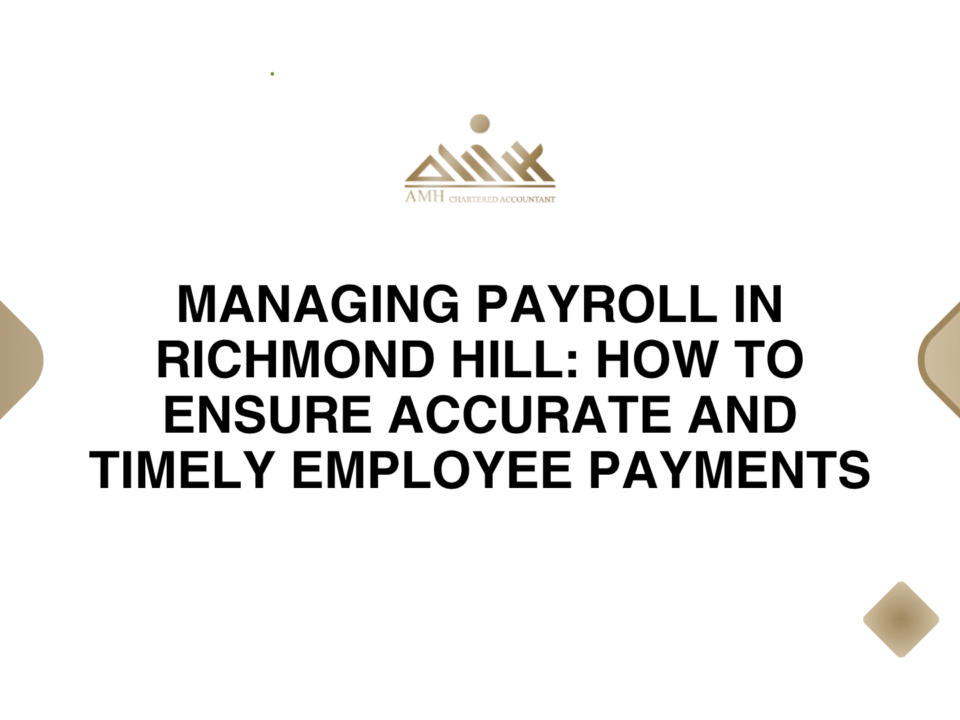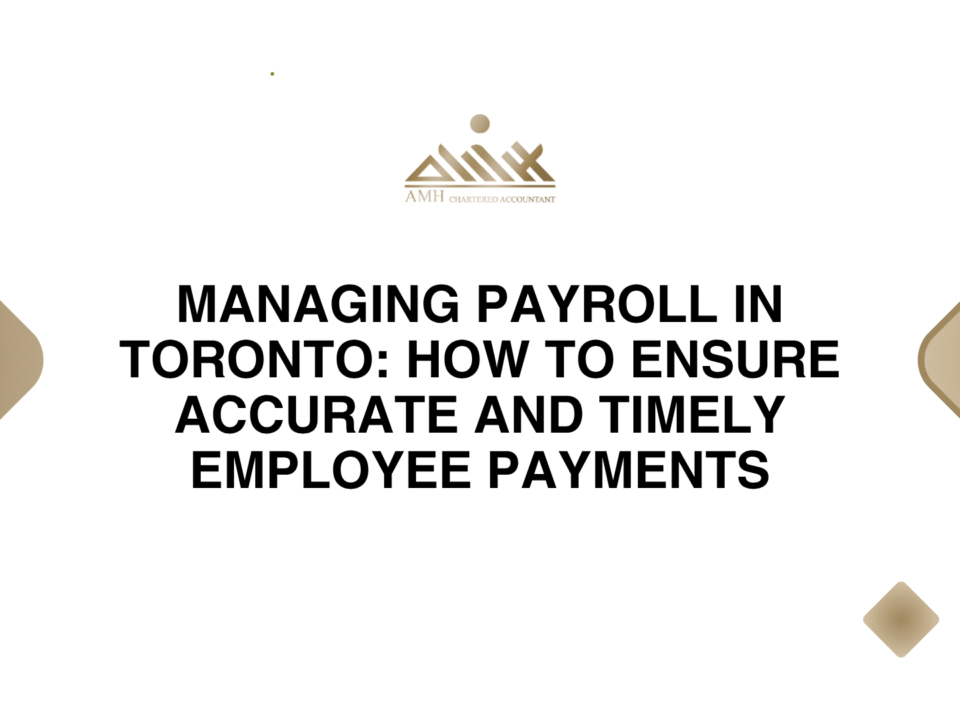
How to Prepare Monthly Financial Reports for Executives and Investors
June 30, 2025
Payroll Management Made Simple: Compliance and Clarity for Employers
July 3, 2025Understanding GST/HST in Your Corporate Books: A Practical Guide
GST/HST compliance is a critical aspect of managing your corporate finances. Understanding how to correctly handle these taxes in your books is essential for maintaining financial accuracy and avoiding penalties. AMH Chartered Professional Accountant provides practical insights to help your business navigate the complexities of GST/HST in your corporate records.
Introduction: The Importance of GST/HST in Your Corporate Books
For any business in Canada, managing Goods and Services Tax (GST) and Harmonized Sales Tax (HST) correctly is essential to ensuring compliance with the Canada Revenue Agency (CRA) and maintaining accurate financial records. Incorrectly handling these taxes can lead to penalties, missed input tax credits (ITCs), and inaccurate financial reporting.
Whether you are a small business or a large corporation based in Toronto, Milton, Oakville, Hamilton, Kitchener, or Waterloo, understanding how to correctly account for GST/HST is crucial for managing cash flow, calculating profits, and filing accurate tax returns.
In this practical guide, we will break down the key steps for managing GST/HST in your corporate books and provide tips for ensuring compliance and efficiency.
What is GST/HST?
The Goods and Services Tax (GST) is a federal sales tax applied to most goods and services sold or provided in Canada. The Harmonized Sales Tax (HST) combines both the GST and provincial sales tax (PST) into one tax in certain provinces.
GST: A 5% federal sales tax applied to most taxable goods and services.
HST: A combined federal and provincial tax applied in provinces that have harmonized their sales tax system. The rate varies by province.
For example, Ontario, Nova Scotia, and New Brunswick charge 13% HST, while provinces like Alberta and British Columbia charge only 5% GST.
Key Differences Between GST and HST
Although both GST and HST serve similar functions in collecting tax on goods and services, the key difference lies in the rates and their application in different provinces:
GST: Applies at a 5% rate across Canada, except in provinces where HST is applied.
HST: The HST combines the federal GST with provincial sales taxes, and the rate varies by province. For instance, Ontario has an HST rate of 13%, while British Columbia and Alberta charge only the GST.
Understanding whether your business is subject to GST or HST based on your location and the nature of the goods and services you provide is crucial for maintaining accurate records.
Who is Required to Collect GST/HST?
Not all businesses are required to collect GST/HST. According to CRA rules, businesses must register for GST/HST if:
Their annual taxable sales exceed $30,000.
They provide taxable goods or services.
They are not exempt or in a special category (e.g., certain healthcare providers or financial institutions).
Even if your business does not exceed the $30,000 threshold, you can voluntarily register for GST/HST to claim input tax credits (ITCs) for tax paid on business expenses.
How to Record GST/HST in Your Corporate Books
Properly accounting for GST/HST involves recording taxes both on the sales your business makes and the purchases you make for business purposes. Let’s walk through the key steps:
Step 1: Understanding GST/HST on Sales
When your business sells taxable goods or services, you must collect GST/HST from your customers. This tax is added to the sale price, and the amount collected is then remitted to the CRA.
Example:
Sale price of a product: $100
GST/HST (13%): $13
Total sale amount: $113
The $13 in GST/HST is not revenue for your business; it is an amount you must collect on behalf of the government.
Step 2: Accounting for GST/HST on Purchases
When your business purchases goods or services for resale or for use in its operations, you will pay GST/HST to suppliers. This tax can be recovered by claiming an input tax credit (ITC).
Example:
Purchase price of supplies: $200
GST/HST paid (13%): $26
Total purchase amount: $226
You can claim the $26 as an ITC on your next GST/HST filing.
Step 3: Managing Input Tax Credits (ITCs)
One of the benefits of GST/HST is that businesses can claim input tax credits (ITCs) for the tax they’ve paid on purchases related to their business operations. This reduces the amount of GST/HST you owe to the CRA.
Eligible ITCs: You can claim ITCs for tax paid on business-related purchases, such as office supplies, equipment, and even certain professional services.
Ineligible ITCs: There are some items that are not eligible for ITCs, such as personal expenses or items used for exempt sales.
To claim ITCs, your business must be registered for GST/HST, and the expenses must be supported by valid receipts and invoices.
Step 4: Filing GST/HST Returns
Once you’ve collected GST/HST from your customers and paid GST/HST on your business purchases, you need to file a GST/HST return to report the amount owed or the refund due. This is typically done on a quarterly or annual basis, depending on your business’s annual taxable sales.
Key Steps in Filing:
Report GST/HST Collected: The total amount of GST/HST collected from customers.
Claim ITCs: The total amount of GST/HST paid on eligible purchases.
Calculate Net GST/HST: Subtract the ITCs from the amount of tax collected to determine if you owe or are entitled to a refund.
Remit or Claim Refund: Pay any outstanding tax owed or apply for a refund if your ITCs exceed the amount collected.
Common GST/HST Errors and How to Avoid Them
Misclassifying Sales: Ensure that all goods and services sold are correctly categorized as taxable, exempt, or zero-rated. Misclassification can lead to tax errors and penalties.
Missing ITCs: Failing to claim ITCs for eligible expenses can result in missed opportunities to recover tax paid.
Incorrect Tax Rate Application: Be sure to apply the correct GST/HST rate for your province, as rates vary by location.
Late Filing or Payment: Failing to file your GST/HST returns on time can lead to late fees, interest, and potential audits.
The Impact of GST/HST on Cash Flow and Profitability
Managing GST/HST is not just about staying compliant—it also has a direct impact on your business’s cash flow and profitability. By effectively managing the collection and remittance of GST/HST, and leveraging ITCs to offset taxes paid on purchases, your business can better manage its liquidity and cash flow.
Moreover, GST/HST should be considered in your pricing strategy. Depending on your business model and the rate of tax, you may need to adjust your pricing to ensure that GST/HST is appropriately covered without negatively impacting profit margins.
How AMH Chartered Professional Accountant Can Assist with GST/HST Compliance
At AMH Chartered Professional Accountant, we provide comprehensive services to ensure that your business stays compliant with GST/HST regulations, including:
GST/HST Registration: Assistance with registering your business for GST/HST and determining the best structure for your needs.
GST/HST Filing and Remittance: We handle your GST/HST returns and ensure timely filing to avoid penalties.
Input Tax Credit (ITC) Management: We help you track and claim all eligible ITCs, ensuring your business maximizes savings.
Ongoing Compliance and Reporting: We offer ongoing guidance to ensure that your business remains compliant with evolving tax laws.
Our team is dedicated to making GST/HST management as simple and efficient as possible, so you can focus on running your business.
Best Practices for Managing GST/HST Efficiently
Keep Detailed Records: Maintain accurate records of all GST/HST transactions, including invoices, receipts, and tax filings.
Review Taxable Sales Regularly: Regularly review your taxable sales to ensure that all applicable transactions are reported accurately.
Use Software for Automation: Leverage accounting software like QuickBooks or Xero to automate tax calculations and streamline reporting.
Stay Informed: Tax regulations can change, so it’s important to stay updated on any adjustments to GST/HST rates or rules that may affect your business.
Technology and Tools for Automating GST/HST Accounting
Automation tools can significantly simplify GST/HST management. Many accounting software platforms provide integrated solutions to handle GST/HST calculations, filings, and reports. Tools such as QuickBooks, Xero, and Zoho Books integrate with your existing accounting systems to automatically apply tax rates, generate reports, and ensure compliance.
The Future of GST/HST in Canada: Trends and Changes
As Canadian tax laws evolve, businesses will need to adapt to changes in GST/HST regulations. Potential trends include increased automation, digital filings, and changes to tax rates or the types of goods and services subject to tax. Staying ahead of these trends is crucial for ongoing compliance.
Conclusion: Mastering GST/HST for Business Success
Understanding and effectively managing GST/HST is essential for every business in Canada. By following best practices, leveraging technology, and seeking expert guidance, businesses can ensure compliance, reduce administrative burden, and optimize cash flow.
At AMH Chartered Professional Accountant, we are committed to simplifying GST/HST management for businesses of all sizes. Whether you’re just starting out or looking to optimize your tax processes, our team is here to help you navigate the complexities of GST/HST with confidence.
FAQs
What is the difference between GST and HST?
GST is the federal tax applied at 5%, while HST is a combined federal and provincial sales tax applied in certain provinces at varying rates.
How do I claim Input Tax Credits (ITCs)?
You can claim ITCs for GST/HST paid on business-related purchases by tracking your receipts and filing them when submitting your GST/HST return.
How often do I need to file my GST/HST returns?
The filing frequency depends on your business’s revenue. Most businesses file quarterly or annually, but larger businesses may need to file monthly.
Can AMH help me file my GST/HST returns?
Yes, we can assist with all aspects of GST/HST filing and compliance, ensuring that your returns are accurate and filed on time.
Is there a threshold for GST/HST registration?
Yes, businesses with annual taxable sales exceeding $30,000 are required to register for GST/HST.




